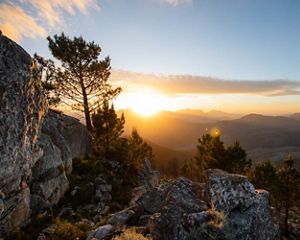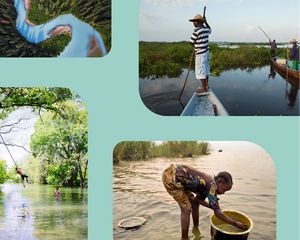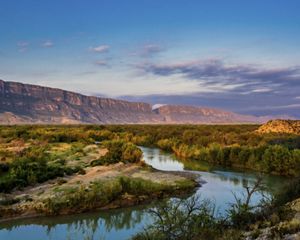Equipping Partners to Secure Their Water Futures
In a changing climate and worsening water crisis, we need collective, immediate action rooted in nature.
By Brooke Atwell and Justus Raepple

Brooke Atwell is TNC's Associate Director of Resilient Watersheds and Justus Raepple is Director for TNC's Nature for Water Facility.
Do you know where your water comes from? In our urbanizing world, it’s easy to miss the connection between what falls from the sky and what flows from our taps.
Yet the climate crisis is increasingly forcing many to confront this question. Like in Cape Town, where a grueling three-year drought nearly completely emptied the South African city’s reservoirs in 2018. Whether through water shortages, crop failures, extreme cycles of flooding and drought, in Cape Town and cities around the world, the story of climate change is already being written in water.
To understand these challenges and what we can do about them, we must go right to the source.
Source watersheds, that is. Watersheds—the lands around rivers, lakes and streams—work hard for people and nature every day. These forests, grassy plains, wetlands and other intact native landscapes filter and store the water that eventually flows through our taps, while providing critical habitat for wildlife (nearly half of the vulnerable terrestrial mammals, amphibians and birds listed by the International Union for Conservation of Nature (IUCN) occur within urban source watersheds).
Restoring the health of our watersheds therefore offers big benefits for wildlife and people—especially as climate change reshapes our future. And increasing investment in nature-based solutions is one important way to get there. We face a critical decade ahead; to support the more than 100 million people on the frontlines of the climate crisis we’ll need to conserve 30 percent of the planet by 2030. No solutions can address the challenges faced by both people and biodiversity on this kind of scale, on this kind of timeline, like nature can.
Of course, The Nature Conservancy (TNC) can’t invest in and restore every watershed in the world alone. Partners on the ground, working in lockstep with communities, are central to these efforts.
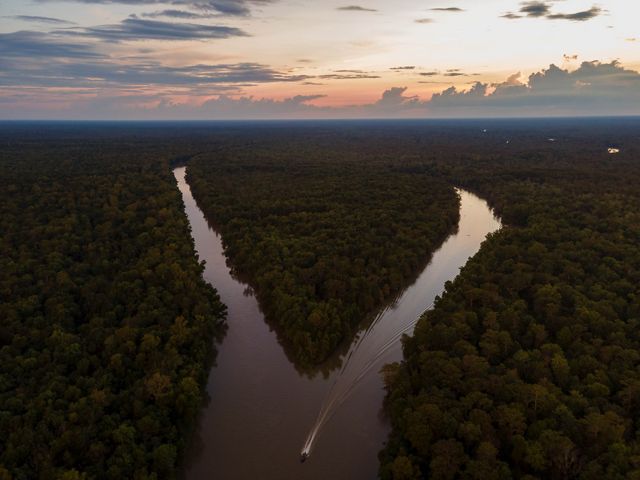
Helping partners turn ideas into action
Our global insights, straight to your inbox
Get our latest research, insights and solutions to today’s sustainability challenges.
Sign Up NowWhile watershed investment and restoration programs can be a win-win solution for communities and nature, financing and launching those projects can be a lengthy, complex process. At the same time, investing in nature represents a paradigm shift for the water sector, and many institutions are wary to make the trade of “the way things are done” for “the way they could be.”
In order to scale up watershed investment, at the pace this decade requires, we need to address these barriers to entry—and fast. That starts with bringing local partners (think: NGO staff, utilities, corporates and development finance institutions) into the fold and equipping them with trainings, tools and technical assistance they need to turn these big ideas into reality. TNC is doing this in the following ways:
- Trainings: TNC has trained over 1,000 practitioners, including tailored trainings for corporate partners whose value-chains reach every corner of the world, and development finance institutions interested in increasing their investment in nature-based solutions as independent and combined green-gray infrastructure projects.
- Tools: Our “Toolbox” centralizes decades of field experience in an easy-to-access platform for sharing guidance, case studies and lessons learned. Take TNC’s Waterproof tool, for instance. This free resource helps partners answer the question “are nature-based solutions a viable option for my watershed?” by providing an estimated return on investment—saving precious time and money in assessing options.
- Technical Assistance: We’ve worked with communities to develop more than 40 water funds around the world. And a growing number of partners are seeing the benefits that these investments in nature-based solutions can bring. TNC has received more than 300 requests for help launching watershed investment programs, and local stakeholders often ask for hand-in-hand support to build and fund these programs.
This last point presents a challenge, though: providing this level of technical assistance takes time, resources and investment. If we’re to meet our 2030 goals and make tangible, on-the-ground impacts for people and nature at a meaningful scale, we need to leverage the enthusiasm, local connections and capabilities of place-based partners interested in championing their own programs.
Quote
No solutions can address the challenges faced by both people and biodiversity on this kind of scale, on this kind of timeline, like nature can.
If we’re going to work at a global scale, in other words, we must find a way to develop watershed investment programs quickly and cost-effectively.
Enter: The Nature for Water Facility. TNC launched this new program at the 9th World Water Forum in Dakar, Senegal, in partnership with sustainable infrastructure consultancy Pegasys. The Facility is a first-of-its-kind consultancy that aims to meet partner demand for developing watershed investment programs and improve water security around the world.
The Nature for Water Facility: Tailored support for lasting security
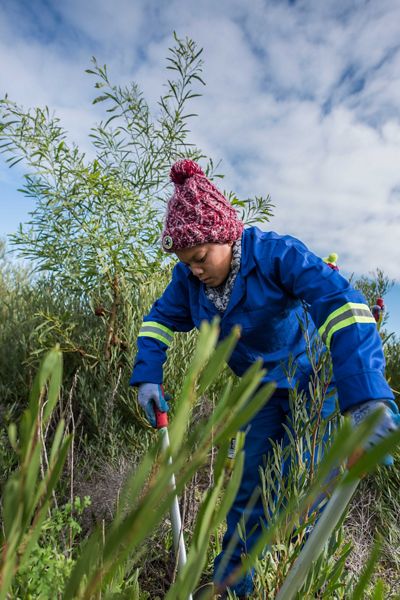
The water sector presents a powerful mechanism to fund biodiversity conservation and climate mitigation and adaptation. Yet despite growing interest in mainstreaming watershed nature-based solutions, they remain less than 0.1 percent of the annual $800 billion in global water sector investment.
A big reason for this “nature gap” is a lack of easily accessible technical assistance to equip local champions with the necessary expertise to originate, design and execute watershed investment programs. The Nature for Water Facility is designed to address this nature gap.
The process of creating a watershed investment program, from idea to execution, can take more than two years. This process requires significant integration across watershed management, governance, ecology, hydrology, GIS, and economics—not to mention the project management required to bring it all together. The Facility will deploy a centralized team of expertise to provide technical assistance to clients looking to start this process. The efforts are two-fold:
- Restore nature to secure water. This includes reforestation, grassland and wetland restoration, soil erosion control and invasive species removal. The Facility’s team of specialist scientists and hydrologists diagnose the critical water challenges in the source water areas feeding a city, and then use modeling to develop a mix of nature-based solutions that will best address the water security challenge, whether it be water quality, quantity or flood risk (just to name a few).
- Drive collective action for lasting impact by bringing together people, communities, organizations and governments. The Facility helps to build teams, arrange decision-makers and design funding approaches to ensure the new watershed investment programs are properly implemented and can thrive for years to come.
The Facility in action: On the ground and at the source
Over the next four years, the Facility plans to support more than 50 watershed investment programs around the world. One project already underway is in South Africa, in the Kruger to Canyons Biosphere Region.
Here, the Facility is working with TNC, Conservation International, Conservation South Africa and other local partners to secure the region’s biodiversity and agricultural economy in a way that filters and secures freshwater in its downstream national park.
“The biggest benefit the Facility has so far offered is capacity and expertise,” says Louise Stafford, TNC’s South Africa Water Funds Director. “With this added support and deep knowledge, we can get to the business case much quicker, saving time and costs in the process.”
Remember that drought in Cape Town? In 2018, Louise also worked with local partners to set up the Greater Cape Town Water Fund—a collective of utilities, agriculture stakeholders, local governments, NGOs and corporations—and saw big benefits.
If watershed restoration is the what, water funds are the how. Water funds are collective action governance programs that bring together different water users to invest in ecosystem protection and communities at water sources.

“Water Funds were the missing link for me,” Louise says, noting that this type of structure brings together NGOs, private business and local government in a way that drives necessary action. The Greater Cape Town Water Fund did just that, devising a plan to fund and mobilize collective action to remove thirsty invasives in the city’s watershed, saving water while restoring habitat and creating green job opportunities. However, the process of building these partnerships and designing and executing this plan took a significant amount of time and staff capacity (from TNC and from partners). In this latest project in Kruger to Canyons Louise looks forward to leveraging the expertise of the Facility to set up a water fund and more easily drive deep, efficient, lasting impact.
Get involved with the Facility
We are excited to work with local partners to help make nature-based solutions a more central part of water security plans in a changing world. The Nature for Water Facility will be issuing a call for project proposals this June, and we encourage partners—utility managers, irrigation boards, NGOs, governments, development banks, and more—to apply.
We know that by working together we can find a way for all life on this planet to thrive. It starts on the ground, in the water, at the source. It starts with each of us.
Global Insights
Check out our latest thinking and real-world solutions to some of the most complex challenges facing people and the planet today.
